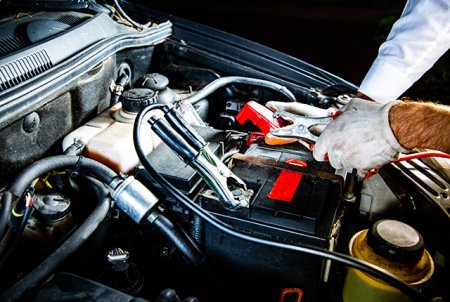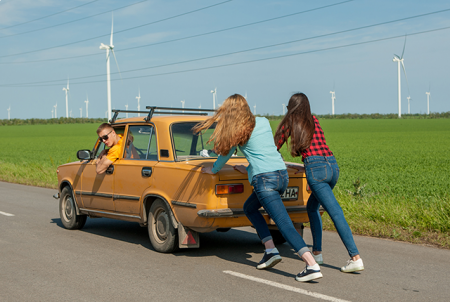JUMP-STARTING – JUST PUSH THE CAR?
NO JUMP STARTER ON HAND AND NO JUMPER CABLES EITHER
Our recommendation ...
Due to the sensitive electronics in the vehicle, only jump-start with a Banner Booster.

Jumper leads can also be used in exceptional cases.
Please note: car-to-car jump-starting can cause voltage spikes during disconnection, damaging or even destroying the vehicle's electronics.
But now for the worst-case scenario: no jump-starter on hand and no jumper cables either!
You can try to push your car with at least a second, or even better a third person, and then start it. This is because pushing creates kinetic energy which, in some vehicles, is transferred from the axle to the engine and thus enables jump-starting.
This basically works when the battery is discharged or the starter motor is defective. Not if the ignition is defective, however, in which case it is best to call the towing or breakdown service straight away. So much for the theoretical part.
Caution: which car can be pushed!
In principle, any car with an internal combustion engine, with a manual gearbox and without a catalytic converter. In the case of petrol engines, it works more simply through the spark plugs; in the case of diesel engines, the glow plugs have to be heated up. The current for this must come from the battery, which may still be possible with a partially discharged battery – but hardly ever with a deeply discharged battery.
Do NOT push cars with catalytic converter or automatic transmission! This also applies to all hybrid cars (Micro, Mild, Full and Plug-in Hybrid).
In a car with a catalytic converter, unburned fuel can get into the catalytic converter and cause damage. In an automatic transmission, the torque converter only works when the engine is running. Pushing is only possible to move the car from where it is, but not for starting the engine. All necessary information can be found in the vehicle owner's manual.
PS: Some car manufacturers take a special approach to the 12V battery. For example, various hybrid models have special jump-start connections in the engine compartment that are connected by cable to the hidden 12V battery. In some very new hybrid models, the Li-Ion drive battery can also be switched on as a starting aid at the push of a button. This then provides enough power for a short time to start the engine. The exact nature of the starting aid for one's own car should therefore be clarified as far as possible before an emergency.
Do NOT push electric cars! (BEV Battery Electric Vehicle)
This cannot work, there is no mechanical clutch! Please also note: The high-voltage system cannot be activated by pushing.
Please be sure to observe the instructions in the vehicle manufacturer's operating manual.

HOW-TO: jump-starting by pushing the car
- Open the driver's window to talk to the people helping.
- Ignition on: turn the ignition key to activate the ignition (do not start).
- The driver gives the command to push the car.
- Driver steps on the clutch, engages second gear (enables smoother starting than with first gear) and keeps the clutch pedal depressed.
- Driver slowly releases the clutch at approx. 10 km/h and accelerates in a controlled manner.
- The pushers continue until the engine starts.
- If everything has worked, the engine starts thanks to the momentum and you can drive off.
- Charging with an external charger is recommended if the battery is discharged. A few kilometres on the motorway are not enough to fully charge the battery. If you suspect a defective starter motor, please visit your trusted specialist workshop quickly.
Here are a few more safety tips.
- Apply the brake harder, no brake booster when the engine isn’t running.
- The steering is also more sluggish when the engine is not running.
- Secure the breakdown site before attempting to start and be sure to keep an eye on the traffic.
- The helpers must wear high-visibility vests!
More articles on this topic

